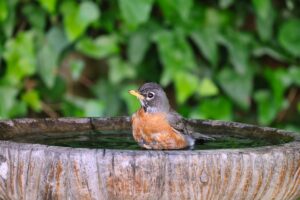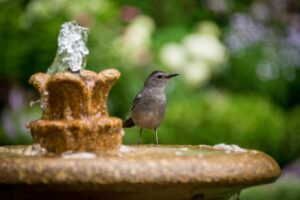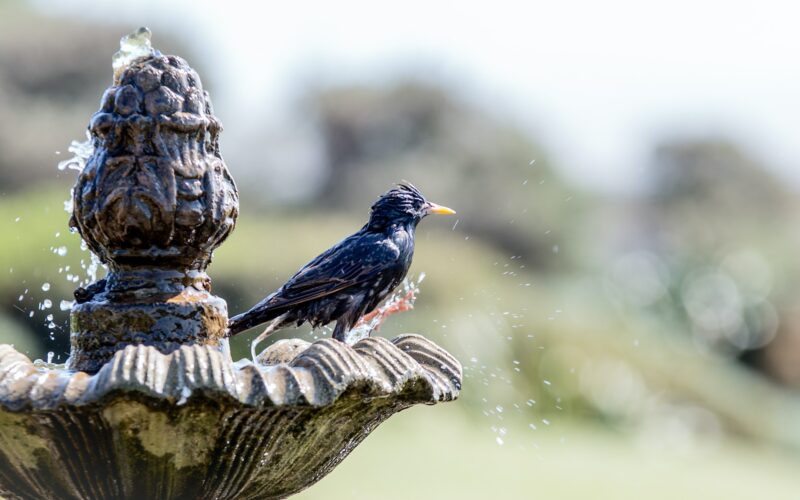Last Updated on January 16, 2024 by Greg Gillson
Adding a bird bath to your bird feeding station is one of the simple things you can do to quickly attract more birds to your backyard.
Birds will love having a reliable source of clean drinking water. Many birds will seek out your bird bath to drink and bathe. And bird baths can provide an attractive yet functional centerpiece to your yard.
When you are setting up your bird bath you have lots of choices as to styles and designs. While you are doing so, don’t for get to add a stone or two. “Why should I put rocks in my bird bath?” you ask.
Putting stones or rocks in your bird bath will provide a shallow and non-slippery perch to more readily attract small birds.
Whether they come to your bird bath for a drink or a bath they may enjoy some strategically placed stones in your bird bath. I recently set up a bird bath in my yard and immediately began enjoying birds coming to drink. Why did I place rocks in my bird bath? Read on!
 |
| Why does my recent homemade bird bath include a rock? |
Put stones in your bird bath to prevent slipping while drinking
Many metal, plastic, or ceramic birdbaths have slippery sides and bottoms. Birds don’t like to slip in the water, and may give up on a bird bath that is too slippery. A rough texture gives a more firm grip to the birds’ feet. But you can add a rough stone to provide a firm landing place instead.
It may work well if the stone you provide is wedge-shaped. Birds can land on the dry upper portion of the rock and then walk down to the water’s edge for a drink. Make sure that the rock is stable and doesn’t wobble.
As you observe birds drinking at your bird bath you may note that most birds dip forward. They fill their beak with water then lift their bill high in the air and allow the water to drain back into their throat.
Some birds, such as pigeons, actually suck water and can keep their head lowered the entire time while drinking. Either way, having a sloping stone to help them get to the water’s edge will be appreciated.
Most birds drink water. Only a few birds get enough hydration simply from the foods they eat. Thus your bird bath will attract many birds for a drink that you would otherwise not be able to attract with foods.
You may think that birds need more water in summer, when the weather is hot and natural water sources may have dried up. That is true. But birds especially need drinking water in winter when water sources may be frozen for days at a time. Yes, birds need water for drinking all year round.

Put rocks in your bird baths that are too deep for bathing
Another reason you should put rocks in your bird bath is too provide a shallow shelf for smaller birds. If water is too deep the birds will not get in for a bath. Many commercial bird baths may look attractive yet not be the easiest for birds to use. For smaller birds the bath edge should only be 1/2 an inch in depth and sloping out to no more than 2 inches deep.
Notice that in the home made bird bath I created (photo above) that I used a slippery glazed ceramic saucer. It is the saucer that sits under a large clay pot planter. Note also that its sides are rather straight up and down, not sloping. It is also rather deep.
The saucer by itself is not an ideal bird bath. But I added a large rock that slopes into the water and another flat stone just under the surface. Now the birds can use it safely. And they do! Of course, the House Finches found it first, as I have a small hanging feeder set up nearby. But even a Black Phoebe came for a bath one evening. If I paid more attention I might even see more birds!
When bathing, birds generally wade belly-deep. Then they dip their head under the surface and quickly raise it. Water flows over the head and down onto the back. The bird flutters its wings and water flies everywhere! At the same time the bird often fans its tail and holds it down in the water, shaking it from side to side. An invigorating bath!
To allow a small bird to bathe in a bird bath that is too deep, add a flat stone just below the surface. Or have a wedge-shaped stone that slopes gently into the water.
Birds bathe in order to keep their plumage clean. After bathing birds often sit on a nearby branch and preen. Birds that are wet from bathing need some time to dry out before they can fly well. Thus they are in more danger from predators after taking a bath.
So having a nearby branch on which to preen and dry, up away from any cats is good. Consider placing the bird bath near a dense bush that small birds can hide in after their bath to protect them from certain hawks, too.
Create a fountain in your bird bath with carefully selected stones
Birds need water for drinking and bathing.
They are really attracted, though, to the sound of gurgling or dripping water. You may really enjoy setting up a recirculating pump to create a small cascading waterfall down an artfully designed grouping of rocks. Or you can buy such a set up.
Make sure that the water flow is not too strong, though. Birds will likely prefer a smaller trickle than an strong flow of water.
If that is too much effort or cost, try a home made dripper.
Poke a hole in the bottom of a plastic gallon jug with screw-on lid. Fill the jug with water. Screw on the lid. Hang it hidden (for esthetics) above a small pool or bowl of water, such that it slowly drips into the water. One drip every two or three seconds is fine and will last at least a couple of hours.
Some birds may prefer a mister or tiny sprayer rather than a waterfall. These may be aimed to splash up on a strategically placed large stone.
Some of these misters are solar powered and float in your bird bath. They need a half hour of sun before they start up, generally. So be sure you place any solar powered fountains or misters so they receive sunlight first thing in the morning or in the evening when birds also visit bird baths before heading off to their night roost.

Wrapping Up
Having a bird bath in your yard offers a surprising number of benefits for both you and the feathered friends:
For the birds:
- Hydration source: Birds lose water through respiration and need regular access to clean water, especially during hot weather. Your birdbath can be a lifesaver for thirsty birds.
- Feather maintenance: Bathing helps birds fluff their feathers, remove dust and parasites, and maintain waterproofing. This keeps them warm, healthy, and able to fly efficiently.
- Natural playground: Birds love splashing and frolicking in water, especially during hot days. A birdbath provides them with a fun and refreshing activity.
- Predator-free zone: By placing your birdbath in a safe location, you offer birds a place to relax and preen without worrying about lurking predators.
- Habitat creation: Birdbaths attract a variety of bird species, increasing the biodiversity in your yard.
For you:
- Entertainment: Watching birds bathe and interact at your birdbath can be a delightful and relaxing experience. You can observe their unique behaviors and learn about different species.
- Natural pest control: Birds attracted to your birdbath often eat insects that might otherwise damage your garden or fruit trees. This can be a natural and effective way to control pests without harsh chemicals.
- Stress relief: Studies have shown that observing nature can reduce stress and improve mood. Watching birds interact at your birdbath can be a soothing and calming experience.
- Connection to nature: Having a birdbath and attracting birds to your yard can help you connect with the natural world around you and appreciate the beauty of these amazing creatures.
Overall, a bird bath is a simple addition to your yard that can bring significant benefits to both you and the birds. It’s a win-win for everyone!
Frequently Asked Questions
What makes a good homemade bird bath?
A good homemade bird bath should be attractive, functional, and safe for our feathered friends. Here are some key elements to consider:
Material
Choose materials that can withstand the elements, like weatherproof concrete, ceramic, or metal. Avoid using materials that can crack or rust easily.
Birds need a textured surface to grip onto while bathing. Consider adding pebbles, rocks, or a mosaic to the bottom of your birdbath.
Aim for a depth of 2-3 inches in the center, shallow enough for small birds to bathe comfortably and deep enough for larger birds to cool off. And don’t forget those rocks in the bottom!
Design
Make sure your birdbath is large enough for several birds to use at once. A diameter of 12-18 inches is a good starting point.
Shallow bowls are great for bathing, while deeper basins can also be used for drinking. Consider adding perches or ledges for birds to rest on.
Place your birdbath off the ground on a pedestal, table, or tree stump. This keeps it safe from predators and makes it easier for birds to spot.
Safety
Avoid placing your birdbath in direct sunlight, as this can heat the water and make it uncomfortable for birds. Choose a shady spot with easy access, away from trees where cats might hide.
Regularly clean your birdbath to prevent the growth of algae and bacteria. Use a mild soap solution and rinse thoroughly
What’s the best material for a bird bath?
Unfortunately, there isn’t a single “best” material for a bird bath, as each has its own pros and cons. The ideal material for you will depend on your priorities and preferences. Here’s a breakdown of some popular materials:
Concrete and Stone:
- Pros: Durable, weatherproof, natural-looking, long-lasting.
- Cons: Heavy, susceptible to cracking in freezing temperatures, expensive.
Ceramic and Glazed Pottery:
- Pros: Attractive, diverse range of styles and colors, easy to clean.
- Cons: Can break or chip easily, not as durable in extreme weather, may require draining in winter.
Metal (Copper, Bronze):
- Pros: Beautiful patina develops over time, durable, weatherproof.
- Cons: Can get hot in the sun, may leach copper into the water in acidic environments, expensive.
Plastic:
- Pros: Lightweight, inexpensive, easy to move, frost-proof.
- Cons: Less attractive than some other materials, can fade in sunlight, can crack or warp over time.
Recycled Materials (Tires, Pots, Saucers):
- Pros: Eco-friendly, creative and unique, budget-friendly.
- Cons: May not be as durable or weatherproof as other materials, requires careful attention to drainage and hygiene.
How do you attract birds to a new bird bath?
Attracting feathered friends to your new bird bath takes a little patience and the right setup, but it’s definitely achievable! Here are some tips to get you started:
Location, Location, Location:
Place your birdbath away from predators like cats, hawks, and squirrels. A spot at least 5 feet from bushes or trees is ideal, giving birds clear escape routes.
Avoid harsh sunlight, especially in hot climates. Aim for dappled shade or morning sun, making the water cooler and more inviting for bathing.
Position your birdbath where birds can easily spot it. Near feeders, hanging plants, or a window is a good option.
Make it Appealing:
Birds are particular about hygiene. Keep the water clean and free of debris by changing it every few days, especially during hot weather. Use a mild detergent solution and rinse thoroughly.
Aim for a water depth of 1-2 inches in the center, with shallower edges for smaller birds. Remember to add pebbles, rocks, or branches for perching and grip.
Birds love the sight and sound of trickling water. Consider adding a solar-powered fountain or dripper for extra allure.
Please read my related article: How high off the ground should a bird bath be?







I really appreciate your information. I'm a casual birdwatcher (is that the term for someone who wants to see birds with their morning coffee) but I do want to make my yard more friendly and helpful to them, particularly as they suffered very much from the heat and wildfires in my area last summer. This gives me a good starting point to make my plans so all of us can enjoy the backyard. Happy birdwatching!
Thanks for the advice. I just set up a bird bath and could see that it was too deep. Now I'm off to hunt rocks!
Bird watcher is a more inclusive term.
The term birder often (not always) is used more for those who go out seeking birds more actively.
A lister is a bird watcher who are concentrating on finding birds they haven't seen before, or seen yet each year, in a specified area (could be county, state, country, or world).
I'm glad you enjoy the information I have provided.
Heat and wildfires has been a frequent theme for many in recent years, including me!
Great! Glad I could help.
Can I use polished river rocks in my bird bath. They are black but probably not dyed
Should be just fine.
Would love some links to good misters/sprayers. I’m not finding any.
Good idea. But I haven't done any research on them yet.
I keep seeing YouTube videos on homemade hummingbird bird baths and fountains with DOZENS of hummingbirds on them. Helps to be on the major hummingbird flyway (coastal California). Something I've GOT to try!
Thanks for the good advice! Is gravel too rough on a bird’s feet? Wondering if I should switch to polished stones to line my birdbath. Thank you!
I would actually think the rough surface is easier to grip–especially as some slippery algae will start to grow.